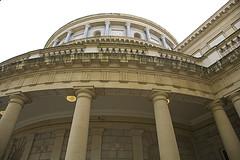 It has an Aquarium (with seals, penguins, sharks and tropical fish) and a draws a walk that resembles the environment of the subtropical jungle. Botanical Garden Park has 7 hectares and is home to 6000 plant species, a botanical library, three gardens (one French, one Roman and one Japanese) style, a herbarium, five greenhouses, a House of English style and 31 sculptures. The French landscape architect Carlos Thays, who created the plans for the most important areas of Buenos Aires, was who designed this park inaugurated in 1898. It has some copies of old trees, as tipas, Salta Cedars, ibira-puitas, chichitas, red quebrachos, carnivals and aguaribayes. It also has foreign as sequoias, magnolias, Oaks, bananas and ginkgoes species. Recoleta / Barrio Norte National Museum of fine arts the the MNBA collection is the most extensive in the country, and one of the most notorious of Latin America. The most important pieces are El Greco, Rodin, Goya, Renoir, Degas, Cezanne and Picasso among others. It is the most important Fine Arts Museum in the country, and it is among the most important in the world, Argentine art collection is the largest in the world. Argentine authors, there are works of Candido Lopez, Spilimbergo, Pueyrredon, Fader, Quinquela Martin, Xul Solar, Berni, Alonso, de la Vega, Gorriarena, Segui and many others. The Museum has a photographic salon, one of Andean pre-Columbian art, two terraces of sculptures and a library with more than 150000 copies. Cemetery of the Recoleta this was the first public cemetery in the city, today it is the most elegant and aristocratic. In its almost 6 hectares is the resting place of founding fathers, Presidents, politicians, soldiers, scientists, artists and celebrities. Monserrat / San Nicolas Obelisk the Obelisk recalls on each of its sides a Buenos Aires historical fact: the first Foundation of 1536; the second and final of 1580; the date on which the national flag was hoisted for the first time in the city in 1812 (at the Church of St.
It has an Aquarium (with seals, penguins, sharks and tropical fish) and a draws a walk that resembles the environment of the subtropical jungle. Botanical Garden Park has 7 hectares and is home to 6000 plant species, a botanical library, three gardens (one French, one Roman and one Japanese) style, a herbarium, five greenhouses, a House of English style and 31 sculptures. The French landscape architect Carlos Thays, who created the plans for the most important areas of Buenos Aires, was who designed this park inaugurated in 1898. It has some copies of old trees, as tipas, Salta Cedars, ibira-puitas, chichitas, red quebrachos, carnivals and aguaribayes. It also has foreign as sequoias, magnolias, Oaks, bananas and ginkgoes species. Recoleta / Barrio Norte National Museum of fine arts the the MNBA collection is the most extensive in the country, and one of the most notorious of Latin America. The most important pieces are El Greco, Rodin, Goya, Renoir, Degas, Cezanne and Picasso among others. It is the most important Fine Arts Museum in the country, and it is among the most important in the world, Argentine art collection is the largest in the world. Argentine authors, there are works of Candido Lopez, Spilimbergo, Pueyrredon, Fader, Quinquela Martin, Xul Solar, Berni, Alonso, de la Vega, Gorriarena, Segui and many others. The Museum has a photographic salon, one of Andean pre-Columbian art, two terraces of sculptures and a library with more than 150000 copies. Cemetery of the Recoleta this was the first public cemetery in the city, today it is the most elegant and aristocratic. In its almost 6 hectares is the resting place of founding fathers, Presidents, politicians, soldiers, scientists, artists and celebrities. Monserrat / San Nicolas Obelisk the Obelisk recalls on each of its sides a Buenos Aires historical fact: the first Foundation of 1536; the second and final of 1580; the date on which the national flag was hoisted for the first time in the city in 1812 (at the Church of St.